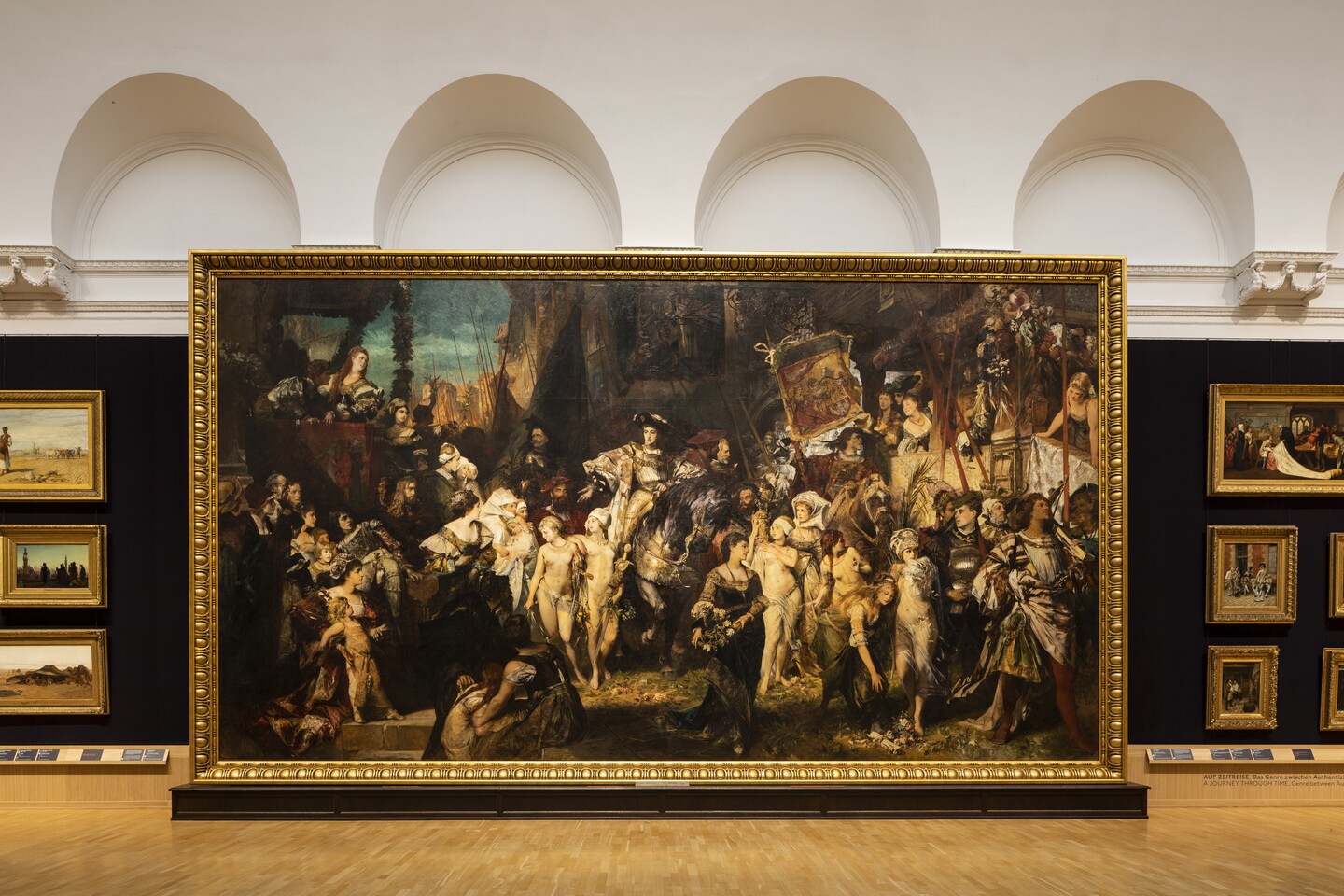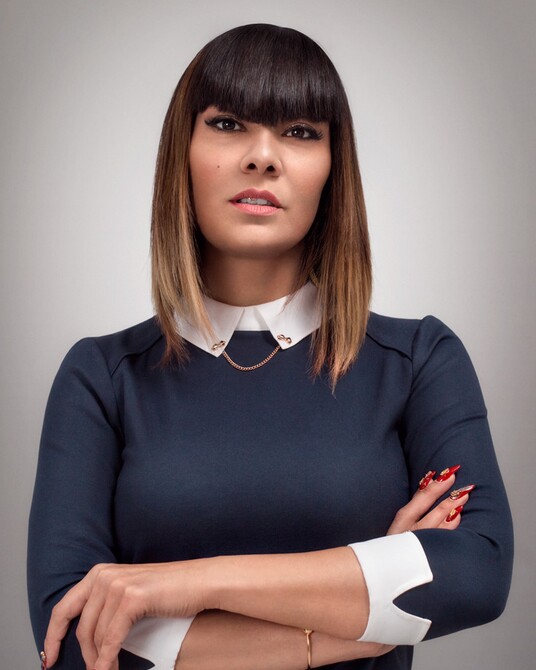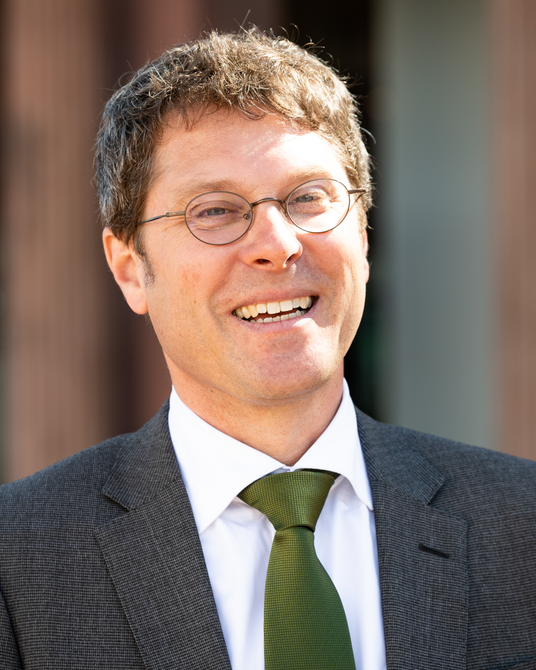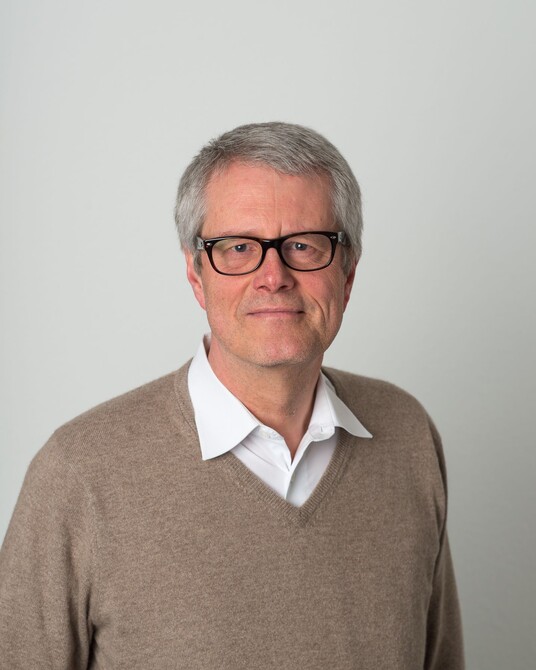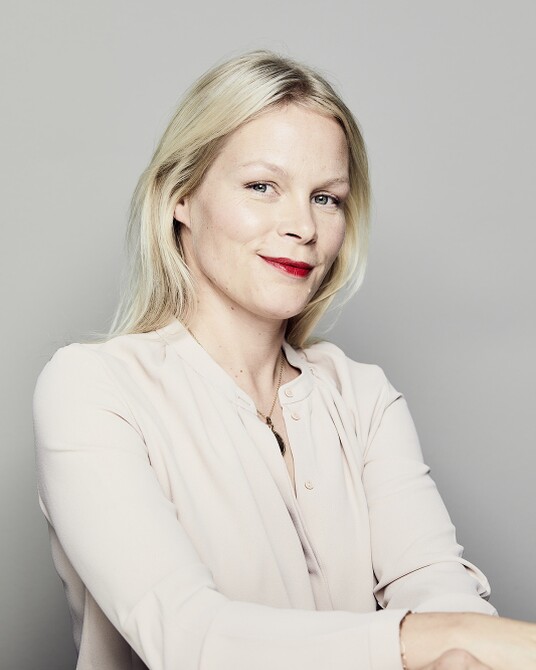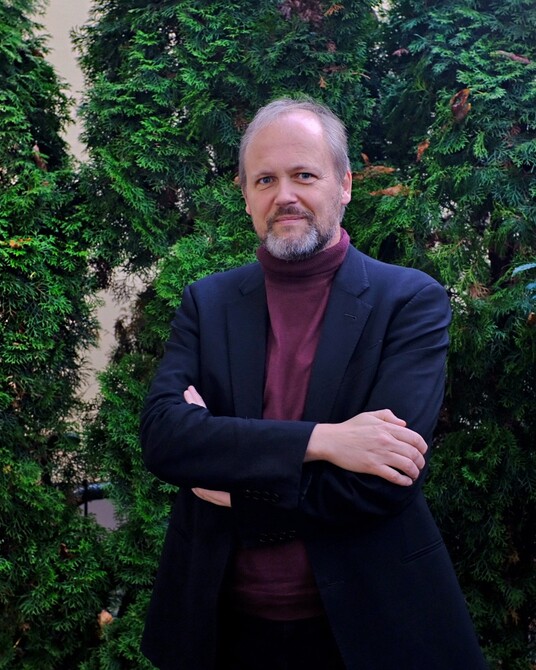#MakartNow
On 1 October 2020, we opened a new collection presentation: MAKING HISTORY - Hans Makart and the Salon Painting of the 19th Century. At the centre of this exhibition is the museum's largest painting, The Entry of Charles V into Antwerp (1878) by Hans Makart (1840-1884). It measures no less than 50 square metres and is one of the most famous paintings in the Hamburger Kunsthalle. Yet it has been and still is the subject of controversial debate. This is due, among other things, to the depiction of the naked young women flanking the ceremonial entry of the Habsburg Emperor Charles V in Antwerp on 23 September 1520 – a historical event that did not take place in this way.
- More
Makart was obviously more interested in provocative staging than in a reliable reproduction of real events. His strategy worked: The monumental painting has since been regarded as one of the scandalous pictures of the era and marks a high point in the painting of historicism. At the same time, it can look back on an eventful exhibition history: The last time it was even hidden behind a wall was in 2016. Since then, it had no longer been on view.
For all these reasons, our director, Prof. Dr. Alexander Klar, has decided to show it again together with around 60 other paintings and sculptures from the 19th century.
Divided into thematic sections, the assembled works tell of the complexity, contradictoriness and seductiveness in the art of that time. Some works offer our contemporary gaze a tightrope walk between eroticism and sexism, participation and voyeurism, fact and fantasy, kitsch and social criticism as well as nostalgia and a backward-looking attitude.
Because we believe that these works – first and foremost Makart's scandalous painting – should be shown, but we want to convey and negotiate such works appropriately, we have developed a special, participatory education concept alongside the catalogue and app, with the motto: »Question art, make up your own mind and share your opinion!«
In addition to the classic on-site screens and questions placed on social media, the concept encourages visitors to look closely at and question the exhibited works and to engage in discussion.
An accompanying booklet, available in analogue form and for download, takes up these very questions and provides partial answers.
The two books Makart Then and Makart Now are available in the hall. They trace the ambivalent reception of Makart’s painting from its beginnings to the present day (Makart Then) and challenge visitors to continue writing about it from our present-day perspective (Makart Now). The hashtag #MakartNow can also be used on social media.
We have also asked well-known authors, feminists and art historians such as Dr. Reyhan Şahin aka Lady Bitch Ray, Mirna Funk, Anne Petersen, Prof. Dr. Wolfgang Ullrich and Prof. Dr. Hubertus Kohle as well as our colleagues for their opinion. Browse through a small but fine selection below and form your own opinion on this basis!
We would also like to ask you for your participation. We are looking for more voices on our Makart. To do so, leave us a message in the book Makart Now when you are on site or by using the hashtag #MakartNow on social media.
- What do you think of Makart's monumental painting?
- Is it scandalous again today?
- Do you find the painting provocative?
- Do you think it is sexist or is this a rhetorical question?
- Are facts as important as imagination?
- How do you see power depicted here?
- How do you think museums should deal with works like this one?Please feel invited to comment on it! We are looking forward to your opinion, because the Makart Hall, as the opening room of the tour through the museum collection, should in the future sensitise all visitors to look at the works exhibited both appreciatively and critically!
From 9 September, a new series of guided tours (in German) on the theme of #MakartNow is planned to start once a month on Thursday evenings, in which staff members will share their very own view of Makart in dialogue with Andrea Weniger (Head of Education & Outreach), present other favourite works from the collection and give insights into their work.
- Dr. Markus Bertsch
»A Kunsthalle without salon painting, without Orientalists, without academic art, without Makart – difficult.
The redesigned Makart Room gives our visitors a vivid impression of how polyphonic and at the same time contradictory the nineteenth-century choir of paintings really was.
Showing these paintings again offers enlightenment in the best sense of the word – although for some eyes they may take some getting used to. Hooray!«DR. MARKUS BERTSCH is curator for the collection presentation Making History and Head of the 19th Century Collection at the Hamburger Kunsthalle.
- Gesa Huget
»I think it’s good that the picture has been unveiled again. For me, it’s first of all the sheer size and the play of light that catches my eye and makes me want to take a closer look. I have never stopped to wonder whether the historical event shown here has been reproduced factually. The pompous staging, the ruler surrounded by naked women, automatically make me think of show and make it obvious that Makart is exaggerating here, putting an imposing story on canvas.
Makart is of course sexist in how he depicts the naked women as trophies of the male ruler. But this is an effective motif that is still widespread today, immediately bringing to mind music videos, for example.«GESA HUGET is Head of Engagement & Patnerships at the Hamburger Kunsthalle.
- Dr. Jan Metzler
»Power, sexism, violence ... How do we as a museum propose to deal with this art? What do we want to say about it? How are we to exhibit it?
As I do not yet have an answer that I find convincing, my personal response is first to pause and reread Klaus Theweleit’s wonderful book MALE FANTASIES. Written 40 years ago, it’s still just as relevant and brilliant as when it first came out. Because the issues of power, violence, class and gender are as pressing as ever these days.«DR. JAN METZLER is Head of Communications & Marketing at the Hamburger Kunsthalle.
- Amelie Baader
»Makart’s colossus wouldn’t pass the would I hang this in my living room test for me, and not just because of its size.
But he was able like no other artist of his day to brilliantly place himself at centre stage and make people talk about him!
Makart is a phenomenon and should not be missing from a collection presentation that aims to show the nineteenth century in all its rich facets and contradictions!«AMELIE BAADER is curatorial assistant for the collection presentation Making History and works on the 19th century collection catalogue at the Hamburger Kunsthalle.
- Jasper Warzecha
»I find the work difficult and it makes me uncomfortable, particularly because Makart’s deliberately excessive depiction of naked women can be understood as sexist.
But to take that as a reason never to show the work again? For me, that’s not an option. Rather, the difficult aspects should be pointed out and addressed. Because in the best case the work stimulates discussions that might even open some people’s eyes.«JASPER WARZECHA was a Research Assistant at the Hamburger Kunsthalle.
- Martina Gschwilm
»Makart’s work generates are so many questions, and that’s what makes the painting so intriguing. Is the work provocative? Yes, hopefully ... or have our viewing habits already become so accustomed to considering such things normal, omnipresent, that we no longer interpret it as provocative? Is the work sexist? That’s already the wrong question, because, objectively speaking, this should not even have to be negotiated anymore. I am nevertheless pleased that the gigantic work measuring 50 square meters is on display again. Presented anew, it allows enough space for all the questions that can still be asked about it. It is the task of a museum to make space for all sorts of thought-provoking impulses, reflections, and also today’s point of view, a task that is also acknowledged in the planned supporting programme.«
MARTINA GSCHWILM is Head of Digital Media at Kunsthalle Hamburg.
- Ute Klapschuweit
»In all the background noise, I have already read and heard so many comments that rip this picture apart. What a fanfare from a bygone era! And now the entire room is tuned to this key. If it is now called sexist – that sounds like so much new morality, so much narrow mindedness and so little generosity! Why not sensual, opulent, splendid, grand – in order to then again become thought-provoking to its detriment or in the form of presentation. In my eyes, this is the Kunsthalle’s great strength. Everything is here – everything is possible – everything is simultaneous! The ghosts of the past – how exciting to be able to conduct a dialogue with them today!«
- Custodial Team
»Our Makart
We think it’s great that our largest painting has been awakened from four years of hibernation. It is after all an impressively large picture with a lot of potential for discussion. No matter how old visitors are and which social class or era they come from. This painting inspires from every angle joyful but also tough discussions. The picture is a wonderful stimulus (provocation) and underscores how morals and values can be judged in so many different ways.«CUSTODIAL TEAM of the Hamburger Kunsthalle
- Larissa Lange
»The question of whether or not the Makart is sexist is, in my opinion, very difficult to answer in a thoughtful way. On the one hand, such works must be considered in their respective (historical) contexts. How did a viewer perceive the work at the time it was created? The fact that it was the target of much criticism even back then lends credence to the charge of sexism, indicating that we don’t just feel that way today. At the same time, one must not forget that nudity and especially naked women are omnipresent throughout the history of art. Are all these works now to be stamped sexist in their own way? Would the Makart here be considered less sexist if he had incorporated mythological figures? Probably the work would then be perceived differently, in my opinion. Despite all these questions, I think the main thing is that works of art, particularly those of such great value and artistic significance, should be exhibited and not hidden away. So thank you for letting us look at it again.«
LARISSA LANGE was a student assistant in the Communications Department at the Visitor's Service of the Hamburger Kunsthalle.
